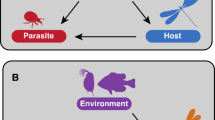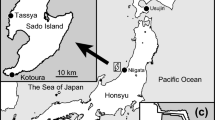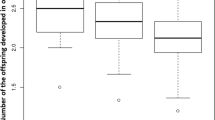Abstract
Sexual selection is often assumed to increase the viability of populations by increasing the quality of offspring produced. Presently, human-induced environmental changes are altering the process of sexual selection by influencing male–male interactions and female mate choice. Here, we show that increased density of filamentous algae due to eutrophication reverses parasite-mediated selection during reproduction in threespine sticklebacks (Gasterosteus aculeatus). When we manipulated the density of artificial algae in a breeding area in the Baltic Sea, more males nested in dense than in sparse vegetation, but the males in dense vegetation were more parasitized. Interestingly, heavily parasitized males acquired more eggs than less parasitized males in dense vegetation but not in sparse vegetation. The higher probability of reproduction for parasitized males in dense algae growth could be due to impaired visibility relaxing male–male competition or reducing female choosiness. This could favour males in poor condition that often invest more in attracting females than males in good condition. In sparse vegetation, parasitized males may have a lower reproductive success due to intense male–male competition, careful female choice and high predation rate selecting against parasitized males. The results suggest that eutrophication could alter the fraction of the population that reproduces, which could have long-term evolutionary consequences.




Similar content being viewed by others
References
Andersson M (1994) Sexual selection. Princeton University Press, Princeton
Axenrot T, Hansson S (2004) Seasonal dynamics in pelagic fish abundance in a Baltic Sea coastal area. Estuar Coast Shelf Sci 60:541–547
Barber I, Ruxton G (1998) Temporal prey distribution affects the competitive ability of parasitized sticklebacks. Anim Behav 56:1477–1483
Bates D (2007) lme4: linear mixed-effects models using S4 classes (version R package version 0.99875-9)
Blais J, Rico C, Bernatchez L (2004) Nonlinear effects of female mate choice in wild threespine sticklebacks. Evolution 58:2498–2510
Bush A, Lafferty K, Lotz J, Shostak A (1997) Parasitology meets ecology on its own terms: Margolis et al. revisited. J Parasitol 83:575–583
Candolin U (1999) The relationship between signal quality and physical condition: is sexual signalling honest in the three-spined stickleback? Anim Behav 58:1261–1267
Candolin U (2000a) Changes in expression and honesty of sexual signalling over the reproductive lifetime of sticklebacks. Proc R Soc Lond B Biol Sci 267:2425–2430
Candolin U (2000b) Increased signalling effort when survival prospects decrease: male–male competition ensures honesty. Anim Behav 60:417–422
Candolin U (2000c) Male-male competition ensures honest signaling of male parental ability in the three-spined stickleback (Gasterosteus aculeatus). Behav Ecol Sociobiol 49:57–61
Candolin U (2004) Effects of algae cover on egg acquisition in male three-spined stickleback. Behaviour 141:1389–1399
Candolin U, Heuschele J (2008) Is sexual selection beneficial during adaptation to environmental change? Trends Ecol Evol 23:446–452
Candolin U, Salesto T (2006) Effects of increased vegetation cover on nesting behavior of sticklebacks (Gasterosteus aculeatus). Behav Ecol Sociobiol 59:689–693
Candolin U, Voigt H-R (2001a) Correlation between male size and territory quality: consequence of male competition or predation susceptibility? Oikos 95:225–230
Candolin U, Voigt H-R (2001b) No effect of a parasite on reproduction in stickleback males: a laboratory artefact? Parasitology 122:457–464
Candolin U, Voigt H-R (2003) Size-dependent selection on arrival times in sticklebacks: why small males arrive first. Evolution 57:862–871
Candolin U, Salesto T, Evers M (2007) Changed environmental conditions weaken sexual selection in sticklebacks. J Evol Biol 20:233–239
Candolin U, Engström-Öst J, Salesto T (2008) Human-induced eutrophication enhances reproductive success through effects on parenting ability in sticklebacks. Oikos 117:459–465
Chappell LH, Hardie LJ, Secombes CJ (1994) Diplostomiasis: the disease and host–parasite interactions. In: Pike AW, Lewis JW (eds) Parasitic diseases of fish. Samara Publishing Limited, Dyfed
Chellappa S, Huntingford FA, Strang RHC, Thomson RY (1989) Annual variation in energy reserves in male three-spined stickleback, Gasterosteus aculeatus L. (Pisces, Gasterosteidae). J Fish Biol 35:275–286
Ehman KD, Scott ME (2002) Female mice mate preferences with non-parasitized males. Parasitology 124:461–466
Emlen S, Oring L (1977) Ecology, sexual selection, and the evolution of mating systems. Science 197:215–223
Engström-Öst J, Candolin U (2007) Human-induced water turbidity alters selection on sexual displays in sticklebacks. Behav Ecol 18:393–398
Estes J, Duggins D (1995) Sea otters and kelp forests in Alaska—generality and variation in a community ecological paradigm. Ecol Monogr 65:75–100
Foster SA, Garcia VB, Town MY (1988) Cannibalism as the cause of an ontogenetic shift in habitat use by fry of the threespine stickleback. Oecologia 74:577–585
Getty T (2002) Signaling health versus parasites. Am Nat 159:363–371
Halpern B, Walbridge S, Selkoe K, Kappel C (2008) A global map of human impact on marine ecosystems. Science 319:948–952
Hamilton WD, Zuk M (1982) Heritable true fitness and bright birds: a role for parasites? Science 218:384–387
Hammerschmidt K, Kurtz J (2005) Surface carbohydrate composition of a tapeworm in its consecutive intermediate hosts: individual variation and fitness consequences. Int J Parasitol 35:1499–1507
Hammerschmidt K, Kurtz J (2009) Ecological immunology of a tapeworms' interaction with its two consecutive hosts. In: Webster JP (ed) Natural history of host-parasite interactions, 1st edn. Academic, London, pp 111–137
Heuschele J, Candolin U (2007) An increase in pH boosts olfactory communication in sticklebacks. Biol Lett 3:411–413
Järvenpää M, Lindström K (2004) Water turbidity by algal blooms causes mating system breakdown in a shallow-water fish, the sand goby Pomatoschistus minutus. Proc R Soc Lond B Biol Sci 271:2361–2365
Kokko H, Rankin D (2006) Lonely hearts or sex in the city? Density-dependent effects in mating systems. Proc R Soc Lond B Biol Sci 361:319–334
Kraak SBM, Bakker TCM, Mundwiler B (1999) Sexual selection in sticklebacks in the field: correlates of reproductive, mating, and paternal success. Behav Ecol 10:696–706
Kraak SBM, Bakker TCM, Hovecar S (2000) Stickleback males, especially large and red ones, are more likely to nest concealed in macrophytes. Behaviour 137:907–919
Kynard BE (1978) Breeding behaviour of a lacustrine population of threespine sticklebacks (Gasterosteus aculeatus L.). Behaviour 67:178–206
Kynard B (1979) Nest habitat preference of low plate number morphs in threespine sticklebacks (Gasterosteus aculeatus). Copeia 3:525–528
Lehvo A, Bäck S (2001) Survey of macroalgal mats in the Gulf of Finland, Baltic Sea. Aquat Conserv: Mar Freshwat Ecosyst 11:11–18
Milinski M (1985) Risk of predation of parasitized sticklebacks (Gasterosteus aculeatus L.) under competition for food. Behaviour 93:203–216
Milinski M, Bakker T (1990) Female sticklebacks use male coloration in mate choice and hence avoid parasitized males. Nature 344:330–333
Moodie GEE (1972) Morphology, life history and ecology of an unusual stickleback (Gasterosteus aculeatus) in the Queen Charlotte Islands, Canada. Can J Zool 50:721–732
Mori S (1993) The breeding system of the three-spined stickleback, Gasterosteus aculeatus (forma leiura) with reference to spatial and temporal patterns of nesting activity. Behaviour 126:97–124
Owen SF, Barber I, Hart PJB (1993) Low level infection by eye fluke, Diplostomum spp., affects the vision of three-spined sticklebacks, Gasterosteus aculeatus. J Fish Biol 42:803–806
Palumbi SR (2001) Humans as the world's greatest evolutionary force. Science 293:1786–1790
Pinheiro J, Bates D, DebRoy S, Sarkar D, the R Core team (2007) nlme: linear and nonlinear mixed effects models. R package version 3.1-83
Poulin R, FitzGerald FG (1989) Risk of parasitism and microhabitat selection in juvenile sticklebacks. Can J Zool 67:14–18
Poulin R, Vickery WL (1993) Parasite distribution and virulence: implications for parasite-mediated sexual selection. Behav Ecol Sociobiol 33:429–436
R Development Core Team (2009) R: a language and environment for statistical computing. R Foundation for Statistical Computing, Vienna, Austria, http://www.R-project.org. ISBN 3-900051-07-0
Rantala MJ, Jokinen I, Kortet R, Vainikka A, Suhonen J (2002) Do pheromones reveal male immuncompetence? Proc R Soc Lond B Biol Sci 269:1681–1685
Real L (1990) Search theory and mate choice 1. Models of single-sex discrimination. Am Nat 136:376–405
Ricker WE (1975) Computation and interpretation of biological statistics of fish populations. Bull Fish Res Board Can 191:1–382
Rowland WJ (1989) The effects of body size, aggression and nuptial coloration on competition for territories in male threespine sticklebacks, Gasterosteus aculeatus. Anim Behav 132:282–289
Sargent RC (1982) Territory quality, male quality, courtship intrusions, and female nestchoice in the threespine stickleback, Gasterosteus aculeatus. Anim Behav 30:364–374
Sargent RC, Gebler JB (1980) Effects of nest site concealment on hatching success, reproductive successs, and paternal behaviour of the threespine stickleback, Gasterosteus aculeatus. Behav Ecol Sociobiol 7:137–142
Seehausen O, Alphen J, Witte F (1997) Cichlid fish diversity threatened by eutrophication that curbs sexual selection. Science 277:1808–1811
Seppälä O, Karvonen A, Valtonen ET (2004) Parasite-induced change in host behaviour and susceptibility to predation in an eye fluke–fish interaction. Anim Behav 68:257–263
Shuster SM, Wade MJ (2003) Mating systems and strategies. Princeton University Press, Princeton
Smith V (2003) Eutrophication of freshwater and coastal marine ecosystems—a global problem. Environ sci pollut Res Int 10:126–139
Wall T, Bjerkås E (1999) A simplified method of scoring cataracts in fish. Bull Eur Assoc Fish Pathol 19:162–165
Wong B, Candolin U, Lindström K (2007) Environmental deterioration compromises socially enforced signals of male quality in three-spined sticklebacks. Am Nat 170:184–189
Wootton RJ (1984) A functional biology of sticklebacks. Croom Helm, London
Worden BD, Parker PG, Pappas PW (2000) Parasites reduce attractiveness and reproductive success in grain beetles. Anim Behav 59:543–550
Zander CD, Reimer LW, Barz K (1999) Parasite communities of the Salzhaff (Northwest Mecklenburg, Baltic Sea). I. Structure and dynamics of communities of littoral fish, especially small-sized fish. Parasitol Res 85:356–372
Acknowledgements
We thank U. Tuomainen, B. Diaz Pauli and S. Greger for help in the field; B. Diaz Pauli and J. Zuckerman for producing artificial algae; M. Kalbe, C.D. Zander, C. Eizaguirre and especially P. Jacobsen for advice on the parasitological investigation; B. Wong, J.W. Boughman and two anonymous reviewers for helpful comments on the manuscript. P. Gienapp kindly helped with parts of the statistical analysis. The work was funded by the Academy of Finland (to UC) and conducted at Tvärminne Zoological Station.
Author information
Authors and Affiliations
Corresponding author
Additional information
Communicated by K. Lindström
Rights and permissions
About this article
Cite this article
Heuschele, J., Candolin, U. Reversed parasite-mediated selection in sticklebacks from eutrophied habitats. Behav Ecol Sociobiol 64, 1229–1237 (2010). https://doi.org/10.1007/s00265-010-0937-9
Received:
Revised:
Accepted:
Published:
Issue Date:
DOI: https://doi.org/10.1007/s00265-010-0937-9




